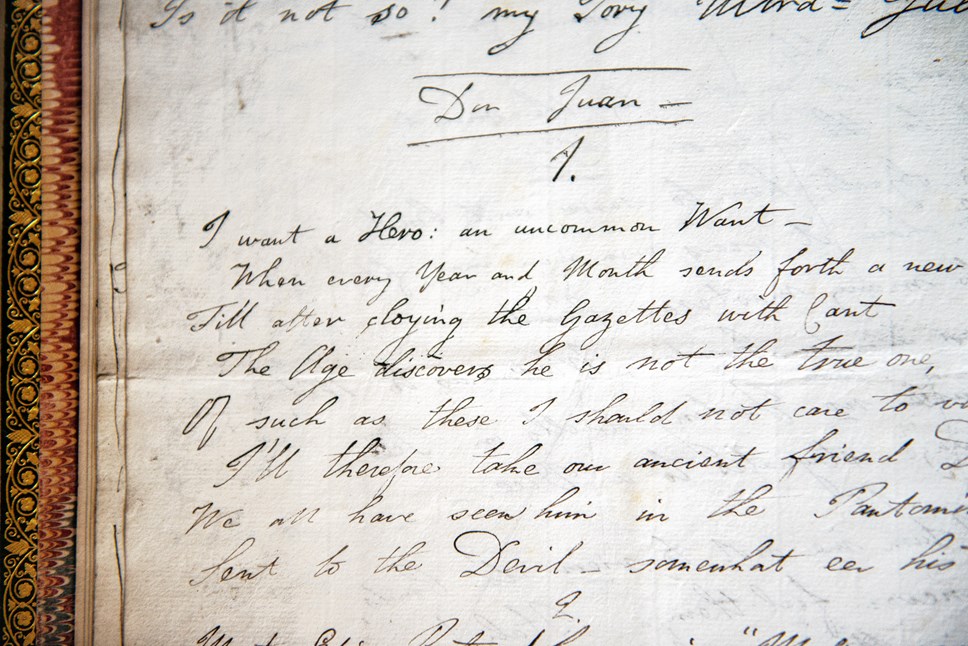
First-ever public display of Byron’s Don Juan
The manuscript of one of the greatest poems of the 19th century – Lord Byron’s Don Juan – will go on display at the National Library of Scotland from next Thursday (18 April) to mark the 200th anniversary of its publication.
Don Juan is widely regarded as Byron’s masterpiece and led Sir Walter Scott to make comparisons with Shakespeare. A long poem divided into sections known as cantos, it was unfinished at the time of his death in 1824.
Often lauded as the first-ever ‘celebrity’, Byron’s private life was already attracting scandal and gossip at the time of writing the first cantos of Don Juan. His account of the adventures of Don Juan is famous for its exotic locations, adventure, romance, wit and dazzling language. As was Byron’s mischievous wont, he also mocked religions and ridiculed fellow poets and public figures.
For the first time, people will have the opportunity to view the working manuscripts of Don Juan on display – specifically cantos I, II and V – which show changes and additions made by the poet, giving an insight into his creative process.
National Librarian John Scally said:
“Lord Byron was at the height of his powers when he penned Don Juan. The epic poem was before its time and he knew it. It was deliberately provocative, but his intent was to expose the hypocrisies of British society as much as it was to shock readers with depictions of war, slave markets, harems, and perhaps most famously, the protagonist’s litany of love affairs.
“We have been collecting Byron’s work for the past 30 or 40 years. The Byron papers in the National Library are a rich and unique research resource and we are proud to be one of the leading centres for the study of Byron’s life and work. It is a special moment to share these manuscripts, in all their raw and immediate detail, with the public.”
The display – which includes an array of material from the Library’s collections relating to Byron, including from the John Murray Archive – explores the controversy surrounding its publication and the reactions of its readers. It runs from Thursday 18 April until Saturday 27 July at the National Library of Scotland, George IV Bridge, Edinburgh.
Background
Born in London in 1788, Lord Byron spent his early years in Aberdeen before inheriting his title on the death of his great-uncle in 1798 and moving to England. Renowned for his looks, he was perhaps most famously described by one of his lovers, Lady Caroline Lamb, as ‘mad, bad and dangerous to know’. He led an unconventional life of extravagant spending and debts, extensive travel, love affairs and separation.
He was outspoken on many subjects, and dismissive of the work of fellow poets including Wordsworth, Coleridge and Robert Southey, the Poet Laureate. All three were the subject of a mocking dedication in Don Juan, which was supressed in early editions of the poem.
Byron had left Britain and was living in Italy at the time of writing Don Juan. Byron’s London friends praised the epic poem, but were concerned about several aspects which they thought readers might find distasteful, controversial or lewd. It was so provocative that his publisher, John Murray, was concerned about being prosecuted. In the end, the first two cantos of Don Juan were published on 15 July 1819 without the author or publisher’s name on the title page.
Blackwood’s Edinburgh Magazine condemned Don Juan as ‘filthy and impious’. The reviewer felt that Byron had turned on his readers by mocking their values: ‘Love–honour–patriotism–religion, are mentioned only to be scoffed at and derided, as if their sole resting-place were or ought to be, in the bosoms of fools’. William Blackwood himself refused to sell it.
At the time of his death in 1824, Byron was resident in Greece, working on the 17th canto of Don Juan. He died age 36.
Contact Information
Notes to editors
The National Library is a major European research library and one of the world’s leading centres for the study of Scotland and the Scots – an information treasure trove for Scotland’s knowledge, history and culture.
The Library holds more than 29 million physical items dating back over 1000 years in addition to a growing library of e-books, e-journals and other digital material. Every week the Library collects around 3,000 new items. Most of these are received free of charge in terms of Legal Deposit legislation.
